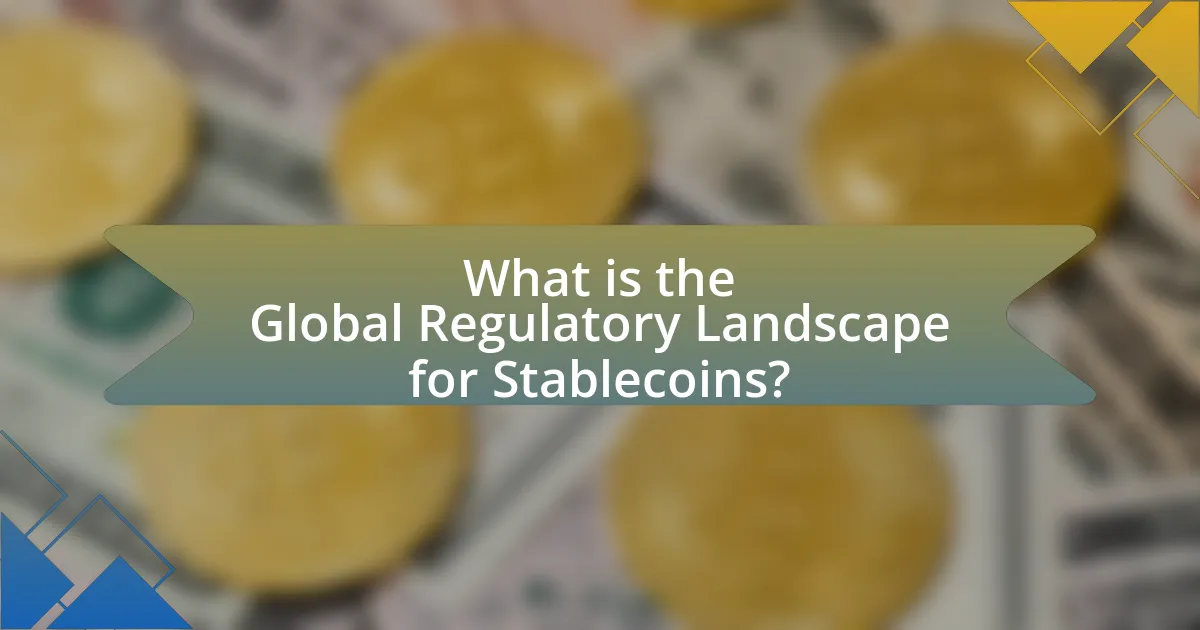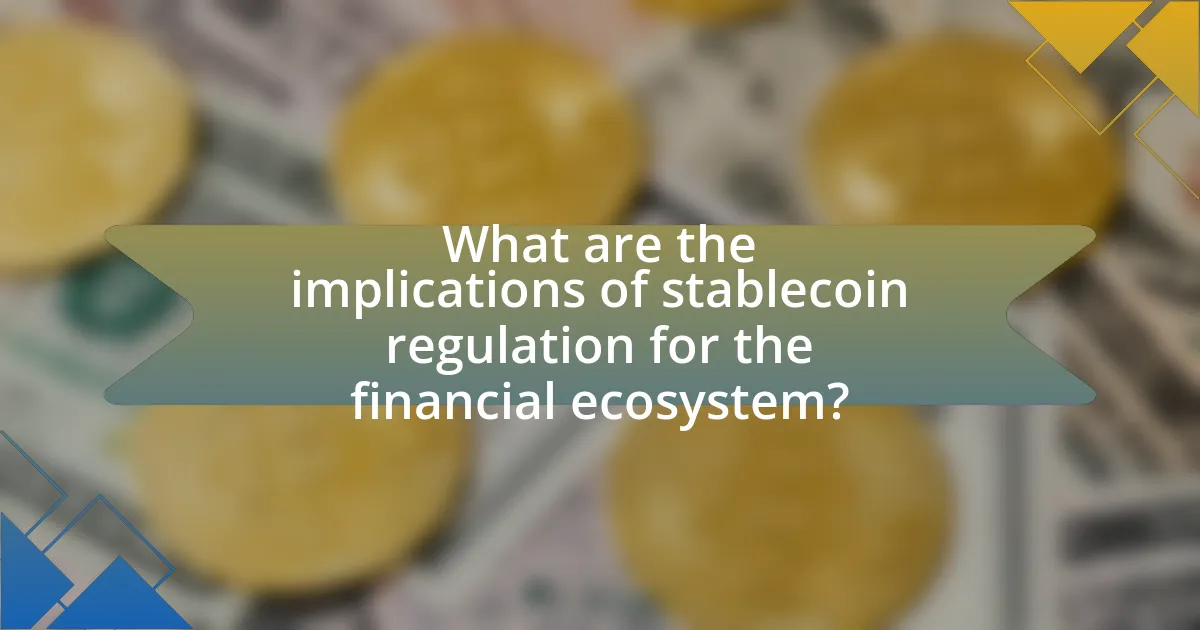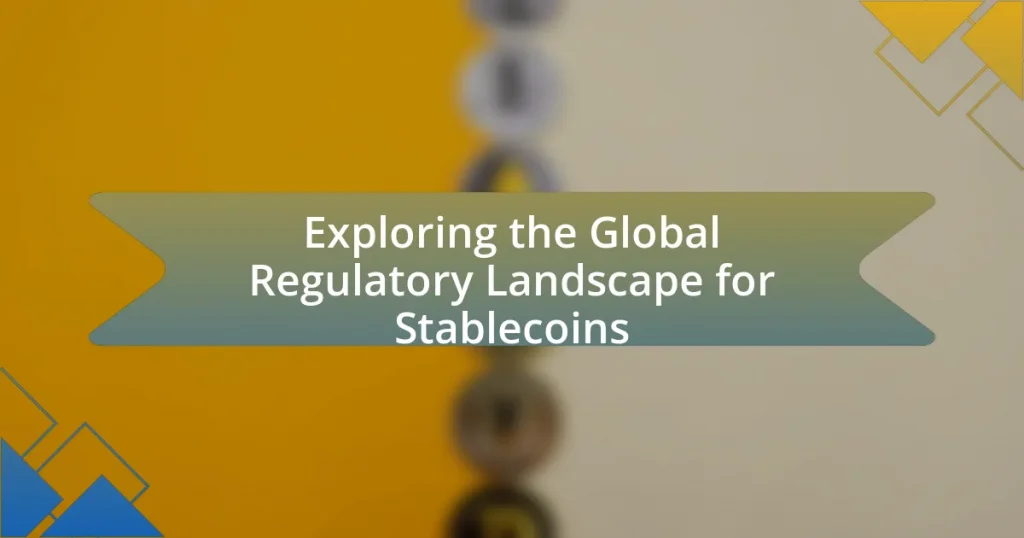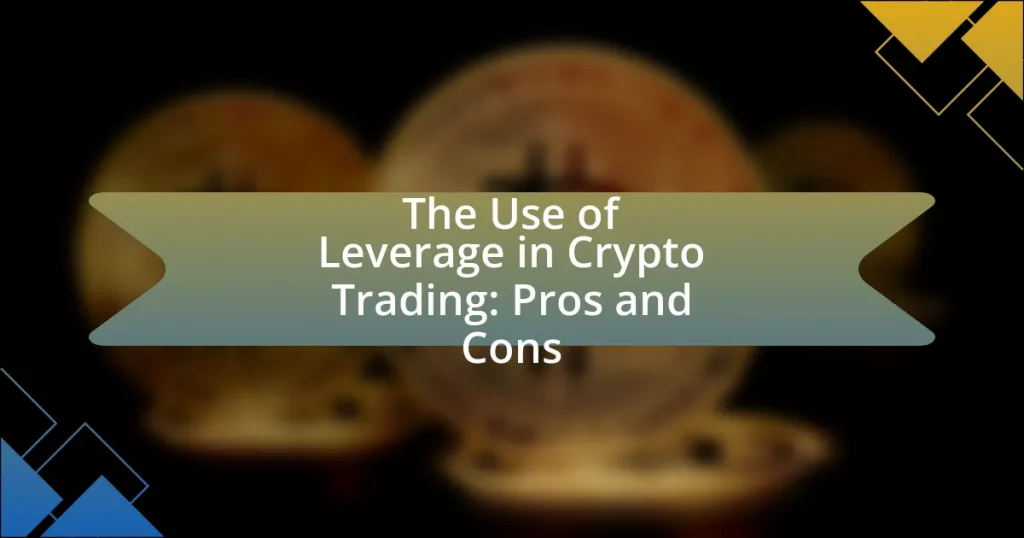The article examines the global regulatory landscape for stablecoins, highlighting the diverse frameworks and approaches adopted by various jurisdictions. It discusses the differences between stablecoins and traditional cryptocurrencies, emphasizing their price stability and key characteristics. The article also addresses the regulatory challenges faced by stablecoins, including consumer protection and financial stability concerns, and outlines the implications of regulatory uncertainty on adoption. Furthermore, it explores the importance of a global regulatory framework, current trends in regulation, and the roles of international organizations in shaping stablecoin regulations, ultimately assessing how these factors influence the financial ecosystem and innovation within the stablecoin market.

What is the Global Regulatory Landscape for Stablecoins?
The global regulatory landscape for stablecoins is characterized by a diverse array of frameworks and approaches adopted by different jurisdictions. Countries like the United States are developing comprehensive regulations that focus on consumer protection, anti-money laundering, and financial stability, as seen in proposed legislation like the Stablecoin Transparency Act. In the European Union, the Markets in Crypto-Assets (MiCA) regulation aims to create a unified regulatory framework for digital assets, including stablecoins, emphasizing investor protection and market integrity. Additionally, nations such as Singapore and Switzerland have established clear guidelines that promote innovation while ensuring compliance with financial regulations. This regulatory diversity reflects varying national priorities and approaches to the risks and benefits associated with stablecoins.
How do stablecoins differ from traditional cryptocurrencies?
Stablecoins differ from traditional cryptocurrencies primarily in their price stability, as stablecoins are pegged to a reserve asset, such as fiat currency or commodities, to minimize volatility. Traditional cryptocurrencies, like Bitcoin and Ethereum, are subject to significant price fluctuations due to market demand and supply dynamics. For instance, Tether (USDT) is a stablecoin that maintains a 1:1 peg with the US dollar, providing users with a more predictable value compared to Bitcoin, which can experience drastic price changes within short timeframes. This fundamental difference in price stability makes stablecoins more suitable for transactions and as a store of value in various financial applications.
What are the key characteristics of stablecoins?
Stablecoins are cryptocurrencies designed to maintain a stable value by pegging their worth to a reserve of assets, typically fiat currencies like the US dollar. Key characteristics include price stability, which is achieved through mechanisms such as collateralization or algorithmic adjustments; transparency, as many stablecoins provide regular audits of their reserves; and regulatory compliance, which is increasingly important as governments seek to establish frameworks for their use. For instance, Tether, a prominent stablecoin, claims to be backed 1:1 by US dollars, providing a clear example of collateralization that supports its price stability.
Why are stablecoins considered a bridge between fiat and crypto?
Stablecoins are considered a bridge between fiat and crypto because they are designed to maintain a stable value relative to a fiat currency, typically the US dollar. This stability allows users to transact in a digital format while avoiding the volatility commonly associated with cryptocurrencies like Bitcoin and Ethereum. For example, Tether (USDT) and USD Coin (USDC) are pegged to the dollar, enabling seamless conversions between traditional financial systems and blockchain networks. This functionality facilitates easier adoption of cryptocurrencies by providing a familiar value reference, thus enhancing liquidity and usability in the crypto market.
What are the primary regulatory challenges facing stablecoins?
The primary regulatory challenges facing stablecoins include concerns about consumer protection, financial stability, and compliance with anti-money laundering (AML) and know your customer (KYC) regulations. Regulatory bodies are particularly focused on the potential risks stablecoins pose to the broader financial system, as their widespread adoption could lead to systemic risks if not properly managed. For instance, the Financial Stability Board (FSB) has highlighted that stablecoins could create issues related to liquidity and credit risk, especially if they are not backed by sufficient reserves. Additionally, the lack of a clear regulatory framework across different jurisdictions complicates compliance efforts for stablecoin issuers, leading to uncertainty in their operational practices.
How do different jurisdictions approach stablecoin regulation?
Different jurisdictions approach stablecoin regulation with varying degrees of oversight and frameworks. For instance, the United States has adopted a fragmented regulatory approach, with different agencies like the SEC and CFTC providing guidance based on the specific characteristics of the stablecoin, while the European Union is working towards a comprehensive regulatory framework through the Markets in Crypto-Assets (MiCA) regulation, which aims to create a unified approach across member states. In contrast, countries like China have implemented strict bans on stablecoin activities, emphasizing a more prohibitive stance. These differences reflect each jurisdiction’s priorities regarding consumer protection, financial stability, and innovation in the cryptocurrency space.
What are the implications of regulatory uncertainty for stablecoin adoption?
Regulatory uncertainty significantly hinders stablecoin adoption by creating an unpredictable environment for issuers and users. This uncertainty can lead to reduced investment in stablecoin projects, as potential investors may fear regulatory repercussions or lack clarity on compliance requirements. For instance, the lack of clear guidelines from regulatory bodies like the U.S. Securities and Exchange Commission has resulted in hesitance among financial institutions to engage with stablecoins, limiting their integration into mainstream financial systems. Furthermore, regulatory ambiguity can deter users from adopting stablecoins for transactions, as they may be concerned about the legal status and potential future restrictions on their use. This situation ultimately stifles innovation and slows the growth of the stablecoin market, as companies may choose to delay or abandon projects due to the risks associated with unclear regulations.
Why is a global regulatory framework important for stablecoins?
A global regulatory framework is important for stablecoins because it ensures consistency, transparency, and security across jurisdictions. Stablecoins, which are designed to maintain a stable value, can pose risks such as market volatility, fraud, and systemic instability if not properly regulated. A unified regulatory approach can mitigate these risks by establishing clear guidelines for issuance, reserve management, and consumer protection. For instance, the Financial Stability Board (FSB) has emphasized the need for comprehensive regulation to address the potential financial stability risks posed by stablecoins, highlighting that without such frameworks, regulatory arbitrage could occur, undermining the integrity of financial systems globally.
How can harmonization of regulations benefit the stablecoin market?
Harmonization of regulations can significantly benefit the stablecoin market by creating a unified framework that enhances trust and stability among users and investors. A consistent regulatory environment reduces uncertainty, which can lead to increased adoption and investment in stablecoins. For instance, when regulations are aligned across jurisdictions, it simplifies compliance for issuers and fosters cross-border transactions, ultimately promoting liquidity and market growth. Additionally, harmonized regulations can help mitigate risks associated with fraud and market manipulation, as seen in the European Union’s proposed Markets in Crypto-Assets Regulation, which aims to provide a clear legal framework for digital assets, including stablecoins. This clarity can attract institutional investors, further legitimizing the stablecoin market.
What role do international organizations play in shaping stablecoin regulations?
International organizations play a crucial role in shaping stablecoin regulations by providing frameworks, guidelines, and recommendations that influence national regulatory approaches. For instance, the Financial Stability Board (FSB) and the International Monetary Fund (IMF) have published reports outlining the risks associated with stablecoins and suggesting regulatory measures to mitigate these risks. The FSB’s report in 2020 emphasized the need for a coordinated regulatory response to ensure financial stability and consumer protection, which has prompted countries to align their regulations with these international standards. Additionally, organizations like the Bank for International Settlements (BIS) facilitate dialogue among central banks, helping to harmonize regulatory practices across jurisdictions. This collaborative effort among international organizations fosters a more consistent and effective regulatory environment for stablecoins globally.

What are the current trends in stablecoin regulation worldwide?
Current trends in stablecoin regulation worldwide include increased scrutiny from governments and regulatory bodies, with a focus on consumer protection, financial stability, and anti-money laundering measures. For instance, the European Union is advancing its Markets in Crypto-Assets (MiCA) regulation, which aims to create a comprehensive framework for crypto assets, including stablecoins, to ensure transparency and accountability. Similarly, the United States is considering legislation that would require stablecoin issuers to maintain sufficient reserves and comply with banking regulations, as highlighted by the recent discussions in Congress regarding the need for a regulatory framework. These trends reflect a global shift towards establishing clear guidelines to mitigate risks associated with stablecoins while fostering innovation in the financial sector.
How are major economies like the US and EU regulating stablecoins?
Major economies like the US and EU are regulating stablecoins through comprehensive legislative frameworks aimed at ensuring financial stability and consumer protection. In the US, the Biden administration has proposed a regulatory framework that includes oversight by federal agencies, requiring stablecoin issuers to obtain bank charters and adhere to existing banking regulations. The Financial Stability Oversight Council (FSOC) has also identified stablecoins as potential systemic risks, prompting calls for stricter regulations.
In the EU, the Markets in Crypto-Assets (MiCA) regulation is being developed to provide a unified regulatory approach for stablecoins across member states. This regulation aims to establish clear rules for issuance, governance, and consumer protection, ensuring that stablecoins are backed by sufficient reserves and comply with anti-money laundering (AML) standards. The European Central Bank (ECB) has also expressed concerns about the implications of stablecoins for monetary policy and financial stability, advocating for a cautious regulatory approach.
These regulatory efforts reflect a growing recognition of the need to address the risks associated with stablecoins while fostering innovation in the digital asset space.
What specific regulations have been proposed or enacted in the US?
The specific regulations proposed or enacted in the US regarding stablecoins include the Stablecoin Transparency Act and the Digital Asset Market Structure and Investor Protection Act. The Stablecoin Transparency Act aims to establish a regulatory framework for stablecoin issuers, requiring them to maintain reserves and provide regular audits to ensure consumer protection. The Digital Asset Market Structure and Investor Protection Act seeks to clarify the regulatory status of digital assets, including stablecoins, and enhance investor protections through registration and compliance requirements. These proposals reflect ongoing efforts by US lawmakers to address the growing influence of stablecoins in the financial system and ensure their stability and security.
How does the EU’s approach to stablecoin regulation differ from the US?
The EU’s approach to stablecoin regulation is more comprehensive and prescriptive compared to the US, which has a more fragmented and less formalized regulatory framework. The EU has implemented the Markets in Crypto-Assets (MiCA) regulation, which establishes clear rules for stablecoins, focusing on consumer protection, market integrity, and financial stability. In contrast, the US relies on existing financial regulations and has not yet created a unified regulatory framework specifically for stablecoins, leading to varying interpretations by different regulatory bodies such as the SEC and CFTC. This difference highlights the EU’s proactive stance in creating a cohesive regulatory environment for stablecoins, while the US approach remains reactive and decentralized.
What emerging regulatory frameworks are being considered globally?
Emerging regulatory frameworks being considered globally for stablecoins include the European Union’s Markets in Crypto-Assets (MiCA) regulation, which aims to provide a comprehensive legal framework for digital assets, and the Financial Stability Board’s (FSB) proposals for a global regulatory framework to address risks associated with stablecoins. MiCA is designed to enhance consumer protection and ensure financial stability, while the FSB’s recommendations focus on the need for consistent regulation across jurisdictions to mitigate systemic risks. These frameworks reflect a growing recognition of the need for regulatory clarity and oversight in the rapidly evolving landscape of digital currencies.
What are the key features of proposed regulations in Asia?
The key features of proposed regulations in Asia for stablecoins include stringent licensing requirements, consumer protection measures, and enhanced anti-money laundering (AML) protocols. These regulations aim to ensure that stablecoin issuers maintain adequate reserves, comply with financial stability standards, and provide transparency in their operations. For instance, countries like Singapore and Japan have introduced frameworks that mandate regular audits and disclosures to safeguard user interests and mitigate risks associated with digital currencies.
How are developing countries addressing stablecoin regulation?
Developing countries are addressing stablecoin regulation by implementing frameworks that focus on consumer protection, financial stability, and anti-money laundering measures. For instance, countries like Nigeria and El Salvador have begun to establish guidelines that require stablecoin issuers to maintain reserves and comply with local financial regulations. In Nigeria, the Central Bank has issued a directive that mandates the registration of cryptocurrency exchanges and the adherence to Know Your Customer (KYC) protocols. Similarly, El Salvador’s adoption of Bitcoin as legal tender has prompted discussions on the regulation of stablecoins to ensure that they do not undermine the national currency or financial system. These regulatory efforts are aimed at fostering innovation while mitigating risks associated with the use of stablecoins in their economies.

What are the implications of stablecoin regulation for the financial ecosystem?
Stablecoin regulation significantly impacts the financial ecosystem by enhancing consumer protection, promoting market stability, and fostering innovation. Regulatory frameworks can mitigate risks associated with volatility and fraud, as evidenced by the European Union’s Markets in Crypto-Assets Regulation, which aims to provide a clear legal framework for stablecoins. This regulation can lead to increased trust among users and investors, as it establishes standards for transparency and accountability. Furthermore, regulated stablecoins can facilitate smoother integration with traditional financial systems, potentially increasing the efficiency of cross-border transactions and reducing costs. Overall, the implications of stablecoin regulation are profound, as they shape the future of digital currencies within the broader financial landscape.
How does regulation impact the innovation of stablecoin projects?
Regulation significantly impacts the innovation of stablecoin projects by establishing frameworks that can either foster or hinder development. Regulatory clarity can encourage investment and innovation by providing guidelines that ensure compliance and consumer protection, as seen in jurisdictions like the European Union with its Markets in Crypto-Assets Regulation (MiCA), which aims to create a unified regulatory environment. Conversely, overly stringent regulations can stifle innovation by imposing high compliance costs and limiting operational flexibility, as evidenced by the regulatory challenges faced by projects in the United States, where uncertainty has led to a slowdown in the development of new stablecoin solutions. Thus, the balance of regulation is crucial in shaping the landscape of stablecoin innovation.
What are the potential risks of over-regulation on stablecoin development?
Over-regulation poses significant risks to stablecoin development by stifling innovation and limiting market participation. When regulatory frameworks impose excessive compliance requirements, they can deter startups and smaller entities from entering the stablecoin market, leading to reduced competition and slower technological advancement. For instance, stringent capital requirements or licensing processes can create barriers that favor established financial institutions, thereby consolidating market power and reducing diversity in stablecoin offerings. Additionally, over-regulation may result in a fragmented regulatory environment, where differing regulations across jurisdictions complicate cross-border transactions and hinder the global adoption of stablecoins. This can ultimately lead to a lack of interoperability and increased costs for users, undermining the fundamental benefits that stablecoins aim to provide.
How can regulation foster trust and security in stablecoin transactions?
Regulation can foster trust and security in stablecoin transactions by establishing clear legal frameworks that govern their issuance and use. These frameworks can include requirements for transparency, such as regular audits and disclosures about reserves backing the stablecoins, which help ensure that the coins maintain their value and are redeemable. For instance, jurisdictions like the European Union have proposed regulations that mandate stablecoin issuers to hold sufficient reserves and provide regular reporting to regulators, thereby enhancing accountability. This regulatory oversight can mitigate risks associated with fraud and mismanagement, ultimately increasing user confidence in stablecoin transactions.
What best practices should stablecoin issuers follow to comply with regulations?
Stablecoin issuers should implement robust compliance frameworks that include thorough Know Your Customer (KYC) and Anti-Money Laundering (AML) procedures. These practices ensure that issuers can verify the identities of their users and monitor transactions for suspicious activities, aligning with regulatory expectations set by financial authorities globally.
Additionally, stablecoin issuers must maintain transparent reserves that back the stablecoins, providing regular audits by reputable third parties to verify that the issued tokens are fully collateralized. This transparency is crucial for building trust and meeting regulatory requirements, as seen in jurisdictions like the United States, where the Financial Crimes Enforcement Network (FinCEN) mandates such practices.
Furthermore, issuers should stay informed about evolving regulations in different jurisdictions, adapting their operations to comply with local laws, such as the European Union’s Markets in Crypto-Assets (MiCA) regulation, which emphasizes consumer protection and market integrity. By following these best practices, stablecoin issuers can effectively navigate the complex regulatory landscape and mitigate legal risks.
How can stablecoin projects ensure transparency and accountability?
Stablecoin projects can ensure transparency and accountability by implementing regular audits and providing real-time access to reserve data. Regular audits by reputable third-party firms verify that the stablecoin is fully backed by reserves, which builds trust among users. Additionally, publishing reserve information on a blockchain allows stakeholders to independently verify the backing of the stablecoin at any time, enhancing transparency. For instance, projects like Tether and Circle have adopted these practices, releasing attestation reports that confirm their reserves match the issued tokens, thereby reinforcing their commitment to accountability.
What steps can issuers take to engage with regulators effectively?
Issuers can engage with regulators effectively by establishing open lines of communication and proactively sharing information about their operations. This involves regularly meeting with regulatory bodies to discuss compliance, providing transparent data on stablecoin usage, and participating in public consultations to voice their perspectives. For instance, issuers can submit detailed reports on their risk management practices and engage in dialogue about regulatory frameworks, which can help build trust and foster collaboration. Engaging in industry associations also allows issuers to collectively address regulatory concerns and advocate for balanced regulations that support innovation while ensuring consumer protection.
What are the future prospects for stablecoin regulation?
The future prospects for stablecoin regulation indicate a trend towards increased oversight and standardization globally. Regulatory bodies, such as the Financial Stability Board and the European Union, are actively developing frameworks to address risks associated with stablecoins, including consumer protection, financial stability, and anti-money laundering measures. For instance, the European Union’s Markets in Crypto-Assets Regulation aims to create a comprehensive regulatory framework for digital assets, including stablecoins, which is expected to be implemented by 2024. This regulatory momentum reflects a growing recognition of the need to balance innovation with risk management in the rapidly evolving cryptocurrency landscape.
How might evolving technologies influence stablecoin regulatory approaches?
Evolving technologies are likely to influence stablecoin regulatory approaches by necessitating adaptive frameworks that address innovations such as blockchain scalability, smart contracts, and decentralized finance (DeFi). As these technologies advance, regulators may need to implement more dynamic regulations that can accommodate rapid changes in the stablecoin ecosystem. For instance, the rise of algorithmic stablecoins, which adjust their supply based on market demand, may prompt regulators to establish guidelines that ensure consumer protection and financial stability. Additionally, the integration of artificial intelligence in transaction monitoring could lead to enhanced compliance measures, requiring regulators to update existing frameworks to incorporate these technological capabilities. The Financial Stability Board has noted that the growth of stablecoins poses potential risks to financial stability, emphasizing the need for regulatory responses that evolve alongside technological advancements.
What trends should stakeholders watch in the coming years?
Stakeholders should watch the increasing regulatory scrutiny and evolving frameworks surrounding stablecoins in the coming years. As governments and financial authorities globally recognize the potential risks and benefits of stablecoins, they are likely to implement more comprehensive regulations to ensure consumer protection, financial stability, and compliance with anti-money laundering laws. For instance, the Financial Stability Board (FSB) has been actively working on guidelines for stablecoin regulation, emphasizing the need for a coordinated international approach. Additionally, the rise of central bank digital currencies (CBDCs) may influence stablecoin regulations, as countries explore digital alternatives to traditional currencies. These trends indicate a significant shift in the regulatory landscape that stakeholders must monitor closely.















